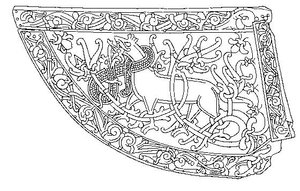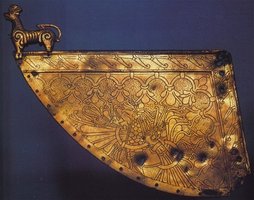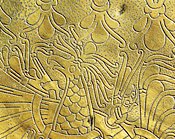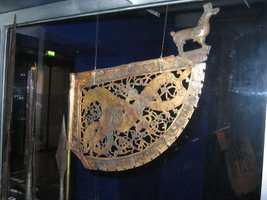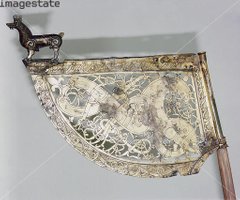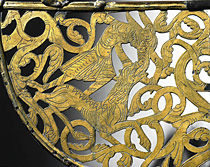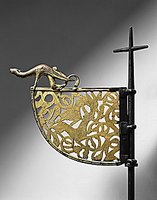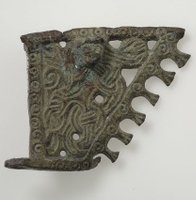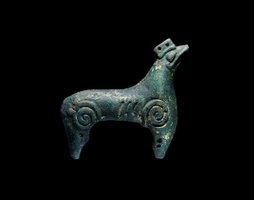Viking Age weather vanes - looking for the stars ?
In this week's blog I like to take you on a sea travel watching the stars..a sea travel, wich ends ultimately on the roof on a church..
Let us start with one of the most intruiging parts of this article. This is, that several of this Viking Age weather vanes actually were found .. on churches !
A pagan artefact in use on a religious building..
How on earth did they get there (presumebaly after use in prior century/centuries on ships) ? It is a question wich answers lays in the Mist of Mystery. Or isn't it ?
As it is, several famous weather vanes were being found on the church spires.
First we have the gilt-broonze vane from Källunge church, Gotland. Designed in the Ringerike style with a so called 'Great Beast' it is remarkably well preserved. As I could not find a photo of this specific weather vane, I added a drawing of it. The 'Great beast' - a distinct characteristic of the Ringerike art style, places it in the 11th century late(r) Viking Age.
The second weather vane was found on Heggen church, Buskerud in Norway. Also cast in a fine Ringerike style, one wonders if some boy in more recent days had tried to shoot the vane of the churh-spire..
As our own Dutch poët Lucebert was saying: 'Everything of value is defenceless'...
The detail is showing us - again - a 'great mythical beast'. A peacock ? One could see this with little phantasy..
The third famous weather vane to be addressed here, is the weather vane from Söderala, Hälsingland in Sweden.
Once again this weather vane is representing state of the art Ringerike style, in a late form of this distinct style.
The common feature on these specific three weather vanes is, that they are remarkably well preserved. Could it be they were in use for just a short period of time at the end of the Viking Age ?
A weather vane from Tingelsted can be dated as late as from the 12th century in a distinct very late Urnes transferring to Romanesque style execution. The more floral motifs and 'lionesque' figures are addressing him to the (beginning) of the Romanesque style.
Even remarkably tiny 'weather vanes' are known. See the image at the right above..
This so called 'miniature weather vanes' were in use to determine a star's height above the horizon.
The type of weather vanes as the one above, from Tingelsted contains marks wich were probably used for measurement of the height of the sun.
Apart from this practical and ingenious use in navigation , weather vanes probably were first and for all of social status. The bronze of which the weathervanes were made was so precious as to make the instruments extremely valuable to the Vikings. But their true importance lay in their usage. The Viking ship which could afford to carry one and an individual who could use it, was able independently to sail the open seas. This made it possible to approach the British Isles and the continent of Europé, and withdraw to the open sea when the situation so required.
Probably the ship carrying the instrument was leading a fleet, and because of ils special status as a flag ship, the instrument functioned as a pennant when not used for navigation
Blindheim (1982) perceived a change in the construction of the weathervanes after the 11th century.
The change could indicate the end of their primary use. Turning them in into an object o social status of .... Christian churches..
Gilded bronze weathervanes appear on the roofs of medieval churches in Sweden, Norway and Finland where they are often regarded as ornamental: symbols of access to resources and craftsmanship for the important families who endowed such buildings. So maybe that is how shiny things at the end turn up on church-spires, independantly of what they represent..
They may have inspired the medieval Norman custom of attaching a gilded weathervane or cock to church roofs, which eventually spread to secular buildings such as castles in France and Italy where their use was restricted to certain ranks of nobility (Lindgrén, 1983).
Thomas Kamphuis, July 10th 2015.
See for references: - as always, I have attached a link to the publications/bookstore where the book can be bought !
Engström, J. New interpretations of Viking Age weathervanes 1996
Graham-Campbell, J. Viking Art p. 124-126, Ringerike-Style-Ship-Vanes, 2013
Lindgrén, S. Viking weather-vane practices in Medieval France in Fornvännen, vol.78, 1983.
Williams, G., Pentz, P. and Wemhoff, M. Vikings life an legend - The British Museum (2014). p. 219, fig. 15 and p. 220, fig. 16.
http://www.timelineauctions.com/lot/the-great-beast-weather-vane-finial/52839/
Link to prior blog June 22th 2015
The two photos above: on the left an animal shaped figure wich would have been on top of a weather vane (finial). On the right: an animal figure from a weather vane, Lolland, Denmark. Both in the Ringerike style, to be recognized at the spiral on the hip and shoulder of the animal.
Well. I could have been with these stones until after dark, but as my wife wanted to travel on.. well.. I see you again, some day, hogback stones from Gosforth. And if you happen to be there one day, do not forget that monument on the outside...
Further on with the Cumbrian hogbacktour !
In - yes, luckily again in - St. Peter's church in Heysham, there is a truly beautiful hogback stone. The guide told us, it had been studyied by Thor Ewing, a writer, in 2000. in 'Understanding the Heysham hogback' A tenth century sculpted stone monument and its context (link), Thor Ewing tells in detail what he dicovered on the both sides of this hogback stone.
Just being brought in the church as late as the 1970's accompanied with some protest here and there among the church visitors, considered as being a token of old paganism, it had been remarkably nice preserved, and a lot of detail can be seen, still. Truly worthwile a visit.
I had a small debate with the guide in the church if the - zoomorphic, in my opinion - faces on the sides were lions (or hippo's). The guide doubted if the vikings could have known about lions. Well I guess so, concerning the runes on the Ancient Greek lion statue at the Arsenal, Venice. For example. Vikings did travel south..
But when he told me he was doubting the vikings 'discovered' (as the native inhabitants were of course, in the first place) America before Columbus, I decided to rest my case..
One has to know when to start and to end a conversation ..
Just discovered the book in a bookstore written by Geoff Holder - The guide to the mysterious Lake District, I knew there had to be another hogback stone in Lowther, St. Micheal's Church. With a promising image described in the text of 'a naval and a land-based force of shield-bearing vikings above a fish and what might be a coiled sea serpent. On the reverse is a row of female figures with snakes, possibly a representation of the hideous hag Hel'. Wow. If that did not sound as a true pagan promised land ..
Not complaing too much after all we have seen, this visit was the dissapointing one of them all. But if you wife states 'I am happy to have seen them' and I am answering 'Measuring is knowing' and the even more obligate verb 'handling 'if we did not see it at all, we wouldn't have known anything at all of how they were looking' the glass was again half full, at the last day of our journey..
The hogback stone appeared to be just being tolerated within the entrance segment part of the church. As something you never use anymore but you do not throw away - entirely. That sort of feeling emerged when seeing this hogback asylum seekers.. Bed, bath and bread, ás we say in Dutch, but no luxury at all and standing on some outcuts of wood, you would balance the table with at home..
Come on, St. Micheal's Church.. care a bit more of your 'children' !
This hogback stone was moved in the church in 1907. Hogback stones layed partially buried in the churchyard before it was dug up and moved into the church.
The promising depiction of a longship - as certainly can be seen after some studying - see http://vikingminds.co.uk/pages/longship
we have missed !
The stone itself is (157 x 50 x 30 cm) and very worn.
The hogback stones in Cumbria - very diverse in quality, but everyone worth a visit ! Especially on a gloomy day in late October ...
The churches to visit - see photos of resp. St. Andrew's church in Penrith, St. Mary's church in Gosforth, St. Peter's church in Heysham and St. Micheal's church in Lowther.
Did I miss out on another one in Cumbria ? Let me know !
In a next blog I will take you to four - still remaining utterly mysterious- statues 'guarding' the graveyard of St. Andrew's church in Dacre..
For the last blog of October 9th see this link.
References: (as always, links to where the books can be ordered are attached).
Edwards, B.J.N. Vikings in North West England - The artifacts (1998);
Emery, Gordon, CURIOUS CUMBRIA, The Lake District & Beyond: A celebration of Cumbria (2023)
Ewing, T. 'Understanding the Heysham hogback' A tenth century sculpted stone monument and its context ;
Hall, R. Viking Age archaeology in Britain and Ireland (first printed 1990, reprinted with amendments in 1995);
Holder, G. The guide to the mysterious Lake District (2009)
possibly also (as there within the part of Cumbria dealing with Carlisle, the Eden Valley, Barrow-in-Furness, Whitehaven and the west coast is being dealed with)
Holder, G. Paranormal Cumbria (2010)
http://vikingminds.co.uk/pages/longship
